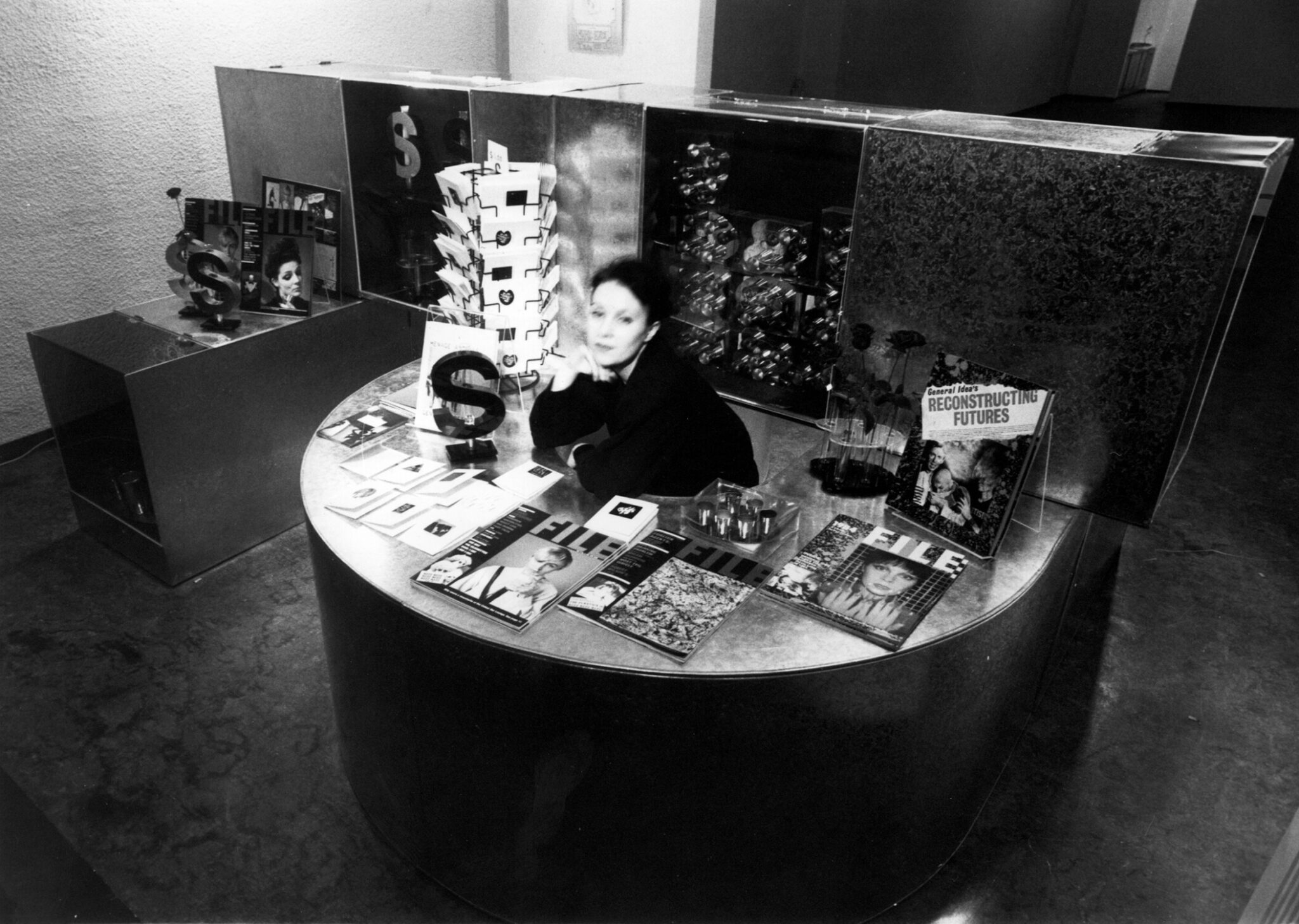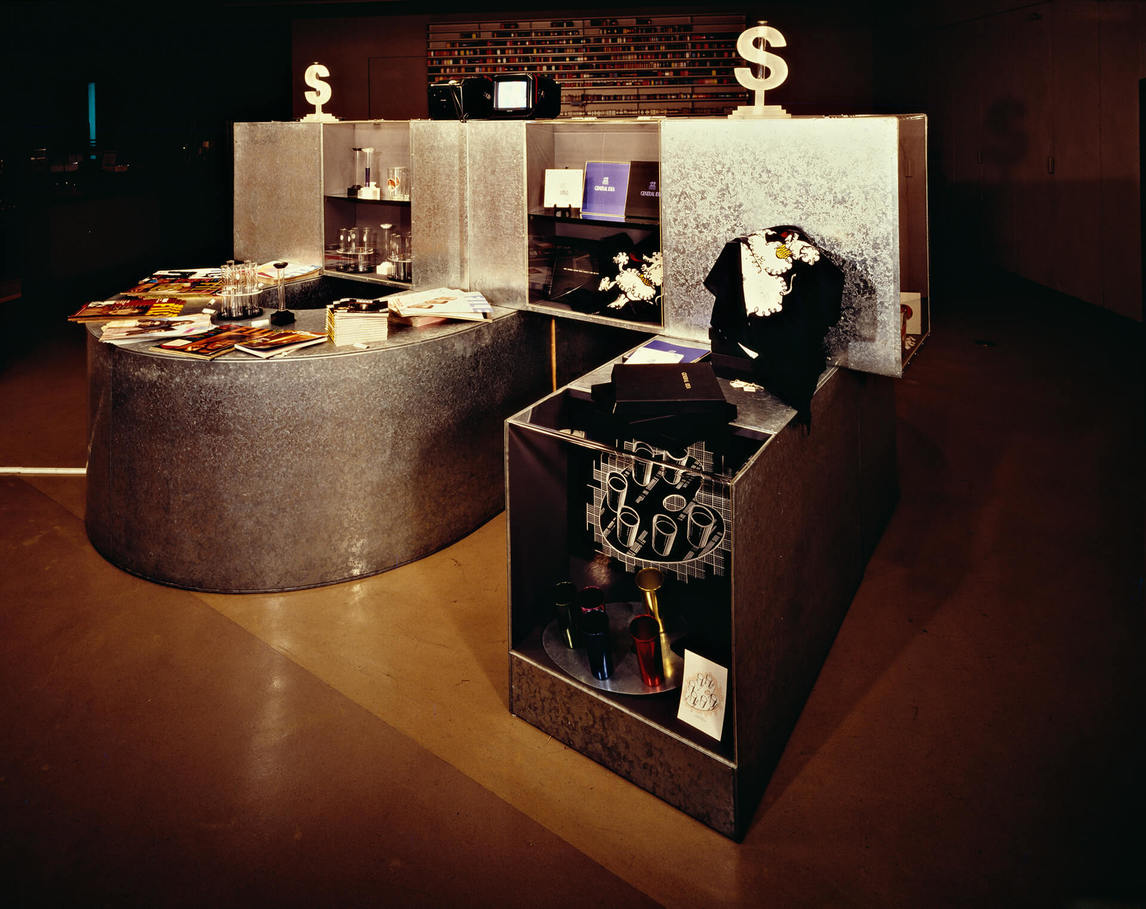The Boutique from the 1984 Miss General Idea Pavillion 1980

General Idea, The Boutique from the 1984 Miss General Idea Pavillion, 1980
Galvanized metal and Plexiglas, containing various General Idea multiples, prints, posters, and publications, 153.7 x 339.1 x 259.1 cm
Art Gallery of Ontario, Toronto
The Boutique from the 1984 Miss General Idea Pavillion is an installation that functions as a retail space, playing with ideas of art and commerce while also challenging the viewer’s typical gallery experience. Taking the form of a three-dimensional dollar sign made of metal, the Boutique was designed to sell General Idea multiples and publications. Many of these multiples, made specifically for and simultaneously with the Boutique, reference props from General Idea’s video work Test Tube, 1979, such as Double Palette, 1980, and Liquid Assets, 1980, both of which were designed to hold test tube–shaped glasses for cocktails. By embedding commerce within the gallery—and art within commerce—General Idea challenged the idea of the museum as a pure space, uninfected by buying and selling.
The 1984 Miss General Idea Pavillion—a fictional edifice the artists proclaimed was destroyed by fire in 1977—referred to in the Boutique’s title was the focus of General Idea’s works between 1977 and 1986. In this period General Idea created projects about the Pavillion that were framed in several ways and included reconstructions of the Pavillion, the creation of fragments as constructs towards the future, as well as the production of archeological remains of the Pavillion. In this way, the past, present, and future of the Pavillion was constantly shifting. As AA Bronson explains, “We muddled up time, mixing the past and future.” The Boutique is presented as an element of the future Pavillion.

The functionality of the Boutique is central to the artists’ commentary. When the work was first presented at Carmen Lamanna Gallery in Toronto in 1980–81, it included a full-time attendant who facilitated purchases. At this initial installation, viewers were allowed to handle the items on display, because it was a retail outlet. In some subsequent displays of the work, it functioned as a shop. For example, it was shown at the ARCO art fair in Madrid; it was positioned in the middle of the gallery shop at SPIRAL in Tokyo; and a salesperson and sales were included at the 49th Parallel Centre for Contemporary Canadian Art in New York.
Other museum displays of the work were unable to function like this due to conflicts with existing museum stores or the stigma associated with inserting commerce into the museum space. For example, some exhibitions did not have an attendant, or did not allow for full access to the multiples, displaying them under Plexiglas. As curator Lillian Tone explains, the Boutique predates a trend now common within museums: “Made at a time when the sound of cashiers still seemed outlandish in the immaculate environment of the exhibition space,” she states, “the Boutique presaged the increasing pervasiveness of temporary shops occupying space once exclusively assigned to art.”
The Boutique also appeared in other General Idea projects. For instance, “The Special $ucce$$ Issue” of FILE Megazine in 1981 was designed as an advertising insert for the Boutiqueand its inventory, promoting the multiples available at the shop. As Tone notes, “Much of the Boutique’s power resides in its ambiguous perception by the public, in the uncertainty of looking at a shop or at an artwork.”

 About the Author
About the Author
 More Online Art Books
More Online Art Books
 Acknowledgements
Acknowledgements